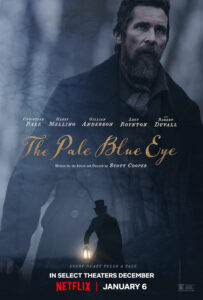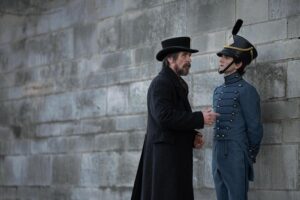Film Review: “The Pale Blue Eye” Too Often Sleepwalks Through Its Mystery
Written by: Christopher Llewellyn Reed | December 22nd, 2022

The Pale Blue Eye (Scott Cooper, 2022) 2 out of 4 stars.
There are, surprisingly, two films released in 2022 that feature 19th-century writer Edgar Allan Poe as a young man during his time at West Point. Raven’s Hollow came out on Shudder in September, and now The Pale Blue Eye drops on Netflix on December 23. I have only watched the first 20 minutes of the former (enough for me), but I did complete my viewing of the latter. There’s no doubt that the casting of Poe is much stronger in the newer film, played by Harry Melling (The Old Guard), who not only looks the part but delivers all the angst and gloom we expect from the man who would eventually pen stories like “The Cask of Amontillado” and poems such as “The Raven.” Unfortunately, despite the presence of a stellar cast, the rest of the movie is heavier on atmosphere than effective storytelling, though it holds our interest for a good while.
The year is 1830 and Christian Bale (Thor: Love and Thunder) stars as August Landor, a former New York City detective now living upstate near the relatively new military academy. Recently widowed, he is doubly bereft since the departure of his daughter, who has apparently run off with someone. Sad as both facts may be, this means he has a lot of free time on his hands, and so when Captain Hitchcock (Simon McBurney, Siberia), West Point’s second-in-command, comes a-calling, asking for help to solve a potential murder (or is it suicide?), Landor accepts.

Once on location, Landor discovers that a young cadet has either hung himself or been strung up by someone else. Worse, his heart was removed post-mortem. As Dr. Marquis (Toby Jones, Empire of Light), the academy physician, explains, whoever did that had to have some knowledge of surgery. Superintendent Thayer (Timothy Spall, Spencer) wants answers before the United Stated Congress cuts their funding. The plot, like blood, thickens.
Enter young Poe, already a published poet yet somehow studying to become an officer. He takes an interest in the case, and Landor drafts him as assistant. Before long, he runs around looking for clues while also wooing Marquis’ daughter, Lea (Lucy Boynton, Bohemian Rhapsody), who suffers from an undisclosed malady, after first befriending her brother, popular fellow student Artemus (Harry Lawtey, Benediction). And though these details might seem extraneous, they do come to bear in the finale, however narratively tortured it might be.

Twists and turns do not always a compelling drama make. Despite the considerable efforts of cinematographer Masanobu Takayanagi (Swan Song) and production designer Stefania Cella, Lucy in the Sky), writer/director Scott Cooper (Antlers) can’t quite escape the inertia of his structure. There is a surprising reveal at the end, as one might hope in a murder mystery, yet the delivery of the information fails to excite. Even the climax just before that, fire and all, falls flat.
It’s also almost criminal to cast actresses such as Gillian Anderson (Margaret Thatcher in Season 4 of Netflix’s The Crown) and Charlotte Gainsbourg (My Dog Stupid) yet barely use them; the same goes for Robert Duvall (The Judge). But Bale is in full depressive mode and his performance, in concert with Melling’s, keeps the enterprise afloat, along with the impressive visuals. It may not be worthy of Poe’s best work, but it’s at least mildly entertaining in some spots.


